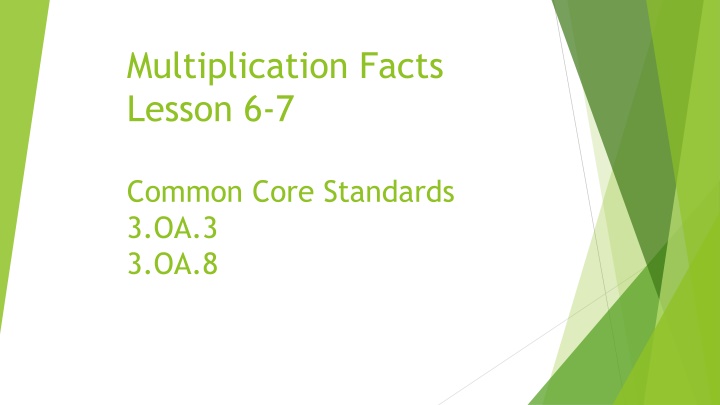
Enhancing Multiplication Skills with Strategic Approaches
Explore strategies for mastering multiplication facts in Lesson 6-7, focusing on using known facts and patterns to find products efficiently. Practice solving problems using arrays, identifying equal groups, and utilizing multiplication patterns. Engage in interactive exercises and discussions to strengthen mathematical reasoning and problem-solving skills.
Download Presentation

Please find below an Image/Link to download the presentation.
The content on the website is provided AS IS for your information and personal use only. It may not be sold, licensed, or shared on other websites without obtaining consent from the author. If you encounter any issues during the download, it is possible that the publisher has removed the file from their server.
You are allowed to download the files provided on this website for personal or commercial use, subject to the condition that they are used lawfully. All files are the property of their respective owners.
The content on the website is provided AS IS for your information and personal use only. It may not be sold, licensed, or shared on other websites without obtaining consent from the author.
E N D
Presentation Transcript
Multiplication Facts Lesson 6-7 Common Core Standards 3.OA.3 3.OA.8
Objective I can use known facts and patterns to find products.
Set the Purpose You have already learned how to use multiplication facts you know to find other facts. Today, you will use strategies to multiply, such as using a pattern and using known facts.
Connect What are some strategies that you can use to help to solve multiplication problems? Using known facts
Pose the Problem Alfred bought 6 bags of oranges. Each bag contains 4 oranges. How many oranges did Alfred buy in all?
Link to Prior Knowledge Why can you use an array to solve the problem? You can use an array because there are equal groups.
Expand Response How can the array help you find 6 x 4? You could add 6 four times. How can you use the twos facts and the fours facts to show the total number for each part of the array? I can break up the array into two parts by separating the top two rows and the bottom four rows. (2 x 4) + (4 x 4) 8 + 16 = 24
Problem 1 Scientists are on a boat studying hammerhead sharks. The length of the boat equals the total length of 6 hammerhead sharks. How long is the boat? Solve and explain. 5 yards long
Writing to Explain Nancy multiplied 8 x 3. Her work is shown below, but her answer is not correct. Explain what she did wrong. Then correctly answer the problem. 8 x3 Count by 3s 3, 6, 9, 12, 15, 18, 20, 23 8 x 3 = 23
1 Point - Weak 8 x 3 = 26 OR 8 x 3 = 24 (The answer is incorrect, or it is correct without an explanation.)
2 Points Some Good Ideas Nancy counted incorrectly. She should have counted: 3, 6, 9, 12, 15, 18, 21, 24 8 x 3 = 24 (The answer is correct, but the explanation is limited.)
3 Points - Strong First, I found the product by adding 3 eight times. 3 + 3 + 3+ 3+ 3 + 3+ 3 + 3 = 24 Then, I looked for a pattern in Nancy s counting. Each count should be 3 more than the number before it when counting by 3s. I found that Nancy added 2 to 18 instead of adding 3. It should be: 3, 6, 9, 12, 15, 18, 21, 24
